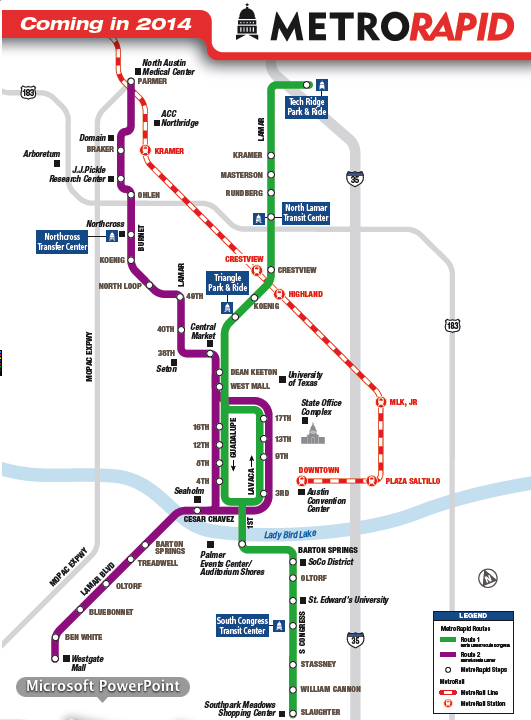For Austin, Wheels in Motion for Bus Rapid Transit by 2014
April 12, 2012 3 Comments
 It’s been a little over two years since MetroRail debuted as Austin’s urban rail. Following a trend that started in Latin America and has spread throughout the world, Austin says it is preparing to break ground on a high-capacity rapid bus. That’s right, ladies and gentlemen, Bus Rapid Transit (BRT) is coming to Austin.
It’s been a little over two years since MetroRail debuted as Austin’s urban rail. Following a trend that started in Latin America and has spread throughout the world, Austin says it is preparing to break ground on a high-capacity rapid bus. That’s right, ladies and gentlemen, Bus Rapid Transit (BRT) is coming to Austin.
Thanks in large part to Department of Transportation grant that will fund 80% of the project, construction of a two-route, $47.6 million rapid-bus system known as MetroRapid will begin this fall. The FTA’s Very Small Starts program will cover some 80 percent $47.6 million total cost.
Capital Metro says MetroRapid can anticipate at least 20,000 daily boardings after the service opens. Plans include two high-capacity, rapid bus lines that would run north-south across the city for a total of 37.5 miles. The North Lamar Boulevard/South Congress Avenue line will run for a total of 21 miles from Tech Ridge Park and Ride to Southpark Meadows. The Burnet/South Lamar Boulevard will total 16 miles and will run from North Austin Medical Center to Westgate Transit Center.

Like other BRT systems, MetroRapid will feature sleek, modern buses that are more efficient and have greater passenger amenities on the bus and at the station that a standard bus. MetroRapid’s fleet will consists of 60 accordion-style buses is expected to run at intervals of 10-15 minutes from 5am to 1am – much shorter than anything Austinites are used to.
The buses would arrive by 2014, and the lines would open after completion of 70 stations that would be located every mile or so, on both sides of the street. Each of these “Enhanced Bus Stops” with a bench, system map, standard route sign and a real-time digital display of anticipated arrival times.
Austins’s far from the only city in North America looking to BRT. In Texas alone, both San Antonio and El Paso
expect to open their own BRT systems within the next 1-3 years.
